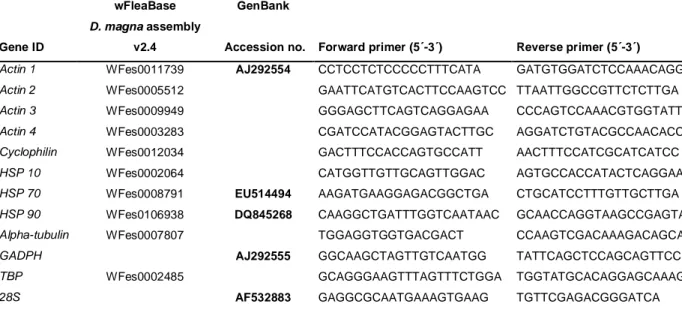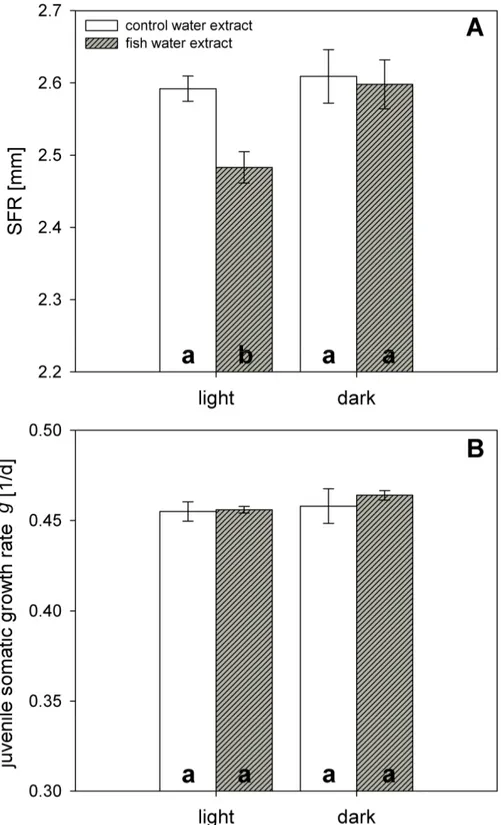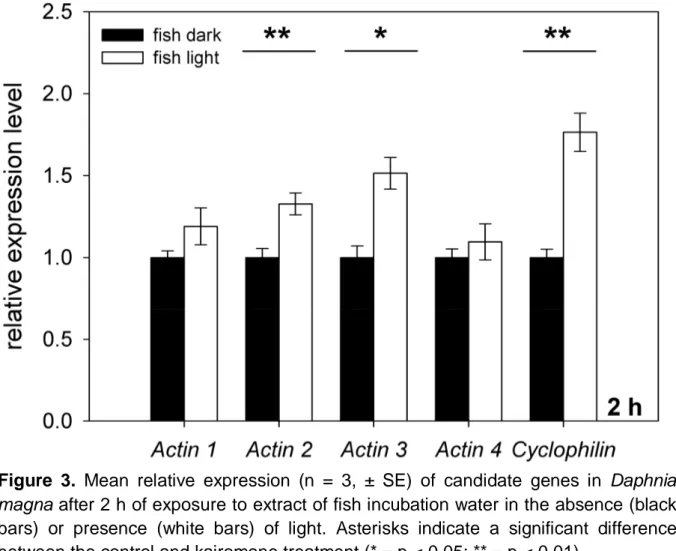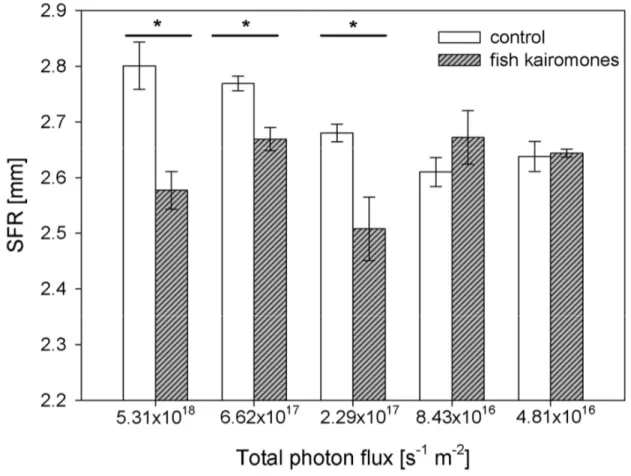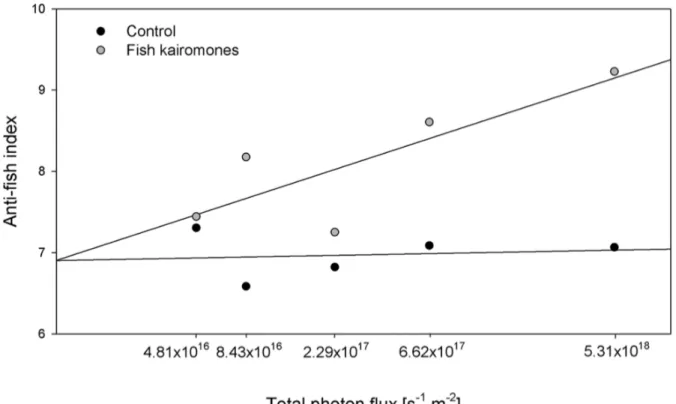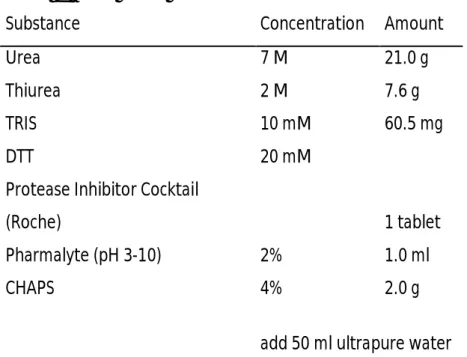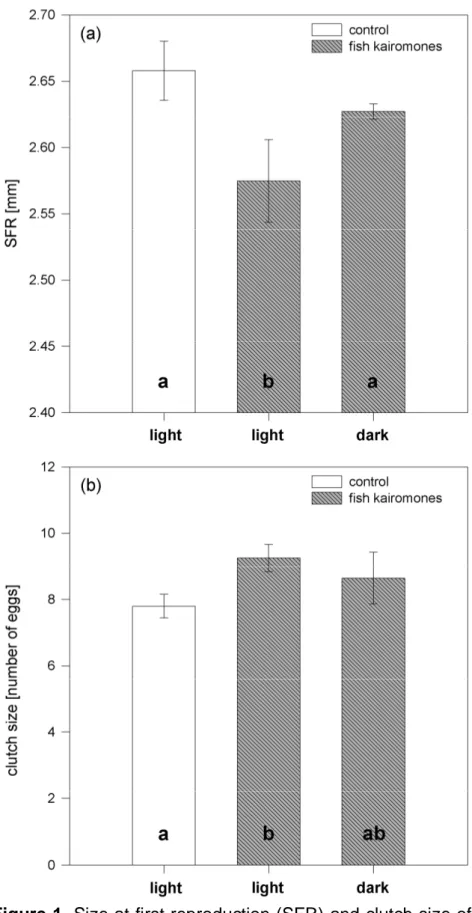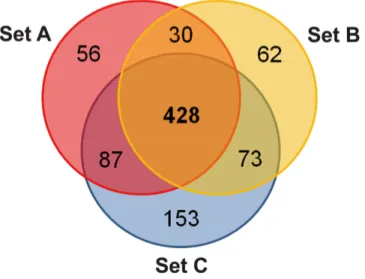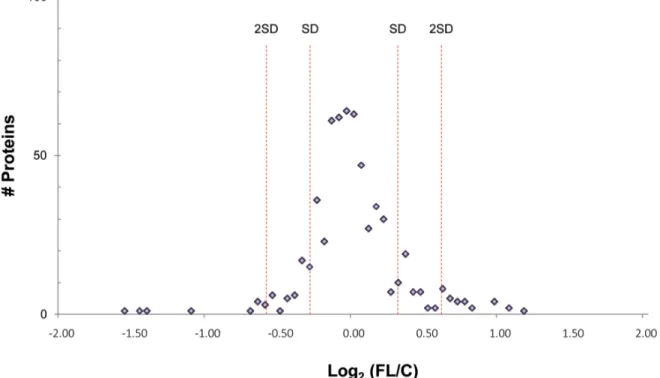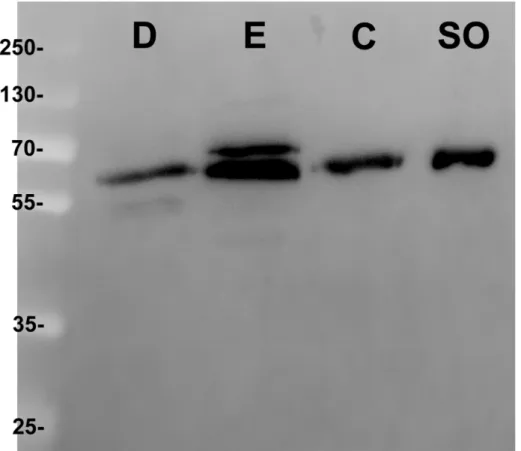Molecular mechanisms of adaptive life-history changes in Daphnia magna
induced by predator kairomones
Inaugural-Dissertation zur
Erlangung des Doktorgrades
der Mathematisch - Naturwissenschaftlichen Fakultät der Universität zu Köln
vorgelegt von Christoph Effertz
aus Köln
Köln 2014
Berichterstatter: Prof. Dr. Eric von Elert PD Dr. Jost Borcherding
Tag der mündlichen Prüfung: 15.10.2014
Für Willi Effertz (04.07.1954 – 15.03.2013)
“Let's drink to the hard working people Let's drink to the salt of the earth Let's drink to the two thousand million Let's think of the humble of birth”
Jagger & Richards
Table of contents
General Introduction and aim of the study 7
1) Light intensity controls anti-predator defences in Daphnia 12 – the suppression of life-history changes
Introduction 14
Material & Methods 17
Results 21
Discussion 27
References 32
2) Coupling of anti-predator defences in Daphnia: the importance 38 of light
Introduction 40
Material & Methods 43
Results 47
Discussion 52
References 55
3) Differential peptide labeling (iTRAQ) in LC-MS/MS based 59 proteomics in Daphnia reveal mechanisms of an anti-predator
response
Introduction 61
Material & Methods 63
Results 71
Discussion 78
References 83
Concluding remarks and perspectives 88
General references 96
Abstract 102
Zusammenfassung 104
Record of achievement 107
List of publications 108
Acknowledgements 109
Erklärung (gemäß §4 Abs (1) Nr. 9) 111
Curriculum vitae 112
7
General introduction and aim of the study
Planktonic crustaceans of the genus Daphnia (order: Cladocera) play an important role as keystone species in almost all standing freshwater ecosystems. As unselective filter feeders, Daphnia are typically the major herbivorous grazers of phytoplankton and are a major prey for predators at higher trophic levels. Due to their important position in freshwater food webs, many studies of the past decades focussed on elucidating the ecological background of Daphnia (Ebert 2005). Further, due to their inherent phenotypic plasticity as a response to various organisms ranging from cyanobacterial phytoplankton to fish predators, Daphnia have become an important model organism for the understanding of links between an organism and its environment (Lampert 2006). In a fluctuating environment, an individual´s probability of survival depends on its ability to cope with environmental changes and phenotypic plasticity describes the ability of an individual (genotype) to express different phenotypes in response to these environmental changes. If the modified phenotype exhibits a higher fitness than the unmodified one, then the phenotypic plasticity is adaptive (Stearns 1992). One potent agent of natural selection, which affects fitness und abundance of organisms in biological communities, is predation.
The introduction of predators has been shown to cause rapid evolution of defensive traits in prey (Seeley 1986; Magurran et al. 1992; Gliwicz 1986; Cousyn et al. 2001).
Although it was shown that predation pressure in freshwater systems is fluctuating over the season in predator type and intensity (Brooks and Dodson 1965; Ringelberg et al. 1991; Weider and Pijanowska 1993), it has led to a variety of adaptive phenotypic defences in aquatic prey organisms (Dodson 1989; Harvell 1990) such as Daphnia.
Daphnia are important prey organisms for both invertebrate predators and vertebrate predators like planktivorous fish, and show a wide range of defences against these predation threats. These anti-predator defences include changes in life-history (LHC), behavioural responses and changes in morphology (Lampert 1994), which were shown to be inducible by chemical cues released by predators (Larsson and Dodson 1993). In particular, these, so-called kairomones released by fish affect the resource allocation in Daphnia leading to LHC, e.g. reduced size at first reproduction (SFR, Weider and Pijanowska 1993). A reduced body size of Daphnia decreases the
8
predation pressure by visually hunting fish (Brooks and Dodson 1965). Another defence against fish predation in Daphnia is the diel vertical migration (DVM) that has been shown to be enhanced by fish kairomones (Loose 1993). DVM is a widespread adaptive migration behavior in Daphnia that results in a reduction of the encounter probability with visually hunting fish: daphnids select the refuge of the deep and dark hypolimnion of stratified lakes at daytime and migrate up into the epilimnion at night (Stich and Lampert 1981; Lampert 1989). The induction of this DVM behavior depends on a relative change in light intensity (Ringelberg 1991; van Gool and Ringelberg 1995).
The inducible character of anti-predator defences like LHC and DVM suggests that anti-predator traits are associated with substantial costs. The inducible character of these defences allows the daphnids to reap the benefits of defence while avoiding potential costs associated with investment in the defensive strategies when they are not needed. These phenotypic benefits and costs have been demonstrated for LHC and DVM. The adaptive reduction of size at first reproduction during LHC goes along with a lower quality of eggs (Stibor and Navarra 2000) and a smaller body size was shown to play a role in a lower competition for food in Daphnia (Gliwicz 1990). The daytime residence of daphnids in cold water layers during DVM results in demographic costs by decreasing growth and development (Dawidowicz and Loose 1992; Loose and Dawidowicz 1994).
A comparison of different D. magna clones exposed to fish kairomones revealed that all tested genotypes had the potential to respond with more than one plastic trait (Boersma et al. 1998), but de Meester & Pijanowska (De Meester and Pijanowska 1996) argued that the exhibition all available defences at the same time may not be adaptive, as selecting one or the most efficient defences against a predator. Although it might be possible that all available defences at a maximum extent could provide the highest protection for an individual, they might be too costly. Under varying predation pressure and to avoid unnecessary costs the accurate adjustment of anti- predator defences to a current predation risk (indicated and induced by the predator kairomones) seems to be crucial for prey organisms. Between Daphnia populations
9 variability was found with respect to the extent of LHC and DVM in response to fish kairomones was found (De Meester et al. 1995), which suggests coexistence of clones that exhibit one or the other defence. Vos et al. showed in a theoretical model that DVM is the preferred defence under high predation risk by fish compared to a reduction in body size (Vos et al. 2002), whereas a reduced body size might be more effective under low predation pressure (Fiksen 1997). However, further support for a coadaptation of both defences in Daphnia comes from a study in which lakes were compared. In habitats in which a Daphnia population is prevented from migration in deeper strata due to lake morphometry or anoxia in the hypolimnion, daphnids underwent LHC, resulting in a shift to an earlier reproduction at smaller size (Sakwinska and Dawidowicz 2005). These findings might hint to a coupling of LHC and DVM in Daphnia. Further evidence for a plastic coupling of LHC and DVM comes from a population of D. catawba, which performed DVM when exposed to fish kairomones; however, when a net barrier prevented migration into deeper strata, a decrease in SFR was observed (Slusarczyk and Pinel-Alloul 2010). Taken together, these findings suggest that DVM and LHC are not strictly coupled; Daphnia appear to be plastic with respect to the degree of response with either defence and it is still an open question, which additional factor besides the fish kairomones might control a possible plastic coupling of anti-predator defences (DVM and LHC) in Daphnia.
In chapter 1, I examined the role of light for the induction of life-history changes (LHC) in Daphnia exposed to fish kairomones. I conducted life-history experiments in the absence and presence of fish kairomones extracts exposed to different light regimes under standardized laboratory conditions. I further explored the relevance of light for kairomone-induced effects on the gene expression of known target genes for fish kairomones in Daphnia. Despite the well-known relevance of light for the induction of DVM, investigations of the induction of LHC have been confined to predator kairomones only (Weider and Pijanowska 1993; Stibor and Lüning 1994;
Von Elert and Stibor 2006). I hypothesized that the light level a given Daphnia genotype is exposed to during a large part of the day, determines the magnitude of the LHC. Accordingly, low light levels should lead to no or very little LHC, and high light levels would lead to stronger LHC in response to kairomones from fish.
10
Chapter 1 describes for the first time how a well-known anti-fish defence in Daphnia is controlled by light and provides a mechanism that allows for a plastic coupling of multiple defences (i.e. LHC and DVM) in a fluctuating environment.
In chapter 1, the experimental animals were exposed to absence and presence of light only to observe the putatively strongest effects, whereas in the field animals are subjected to alternating periods of light and dark and different light intensities.
Chapter 2 examines the question whether LHC in Daphnia are controlled by different light intensities and if a light intensity threshold for the fish kairomone induced LHC exists. Therefore, I performed life-history experiments in the absence and presence of fish kairomone extracts and the experimental animals were exposed to five different light intensities, which were supposed to be comparable with light intensities in the field (Tilzer et al. 1995). While chapter 1 aims to reveal the mechanism of LHC controlled by light intensity in Daphnia, chapter 2 continues the research with respect to the specific role of light intensity in the coupling of anti-predator defences under more natural conditions.
Although the Daphnia genome and the molecular tools are available (Colbourne et al.
2011), there is not much known about the molecular mechanisms, that may underlie the anti-predator defences induced by fish kairomones in Daphnia. In chapter 1 I conducted a candidate gene approach for the fish kairomones effects on the gene expression of Daphnia in the absence and presence of light, with genes (actin, cyclophilin and HSPs) that were recently shown to play a role in the response of Daphnia exposed to fish kairomones (Schwarzenberger et al. 2009; Pijanowska and Kloc 2004; Pauwels et al. 2007). I further explored the analyses on the gene level in Daphnia exposed to fish kairomones under five different light intensities in chapter 2.
It is hypothesized that, compared to results of the life-history experiments, the expression level of candidate genes for fish kairomones will be affected by light intensities in the same way as the LHC.
I continued the research on the underlying molecular mechanisms of LHC in Daphnia via proteomics approach described in chapter 3. The actual phenotype of an organism is reflected in its proteome and it is known that the mRNA level does not
11 necessarily serve as an accurate predictor for the respective protein abundance (Anderson and Seilhamer 1997; Gygi et al. 1999; Nie et al. 2006). In contrast to the candidate gene approach conducted in chapter 1, a holistic proteomics approach might elucidate the role of unpredicted functional proteins that could explain phenotypic plasticity in Daphnia. It had previously been demonstrated that LC- MS/MS based proteome profiling in Daphnia using high throughput proteomics based upon the Daphnia genome database is feasible (Froehlich et al. 2009). I performed life-history experiments in the presence and absence of highly purified fish kairomone extract under different light conditions and only animals that showed the expected anti-fish response were used for the proteome analysis. Chapter 3 describes for the first time the application of differential peptide labelling (iTRAQ) in LC-MS/MS based proteomics in Daphnia with the aim to identify kairomone-responsive proteins in Daphnia, which might explain the fish-kairomone mediated phenotypic changes.
In summary, this study presents novel and deep insights into the mechanisms underlying a well-known inducible anti-predator response in Daphnia. Many studies described defences like DVM or LHC separately and only a few studies were conducted that indicate a possible coupling of these defensive strategies. The present study elucidates for the first time the role of the environmental factor light as a mediator between migration behaviour and changes in life-history in Daphnia exposed to fish kairomones. Such a light-mediated coupling allows for a plastic adjustment to fluctuating environments and simultaneously minimizes the associated costs of multiple alternately deployable defences. Furthermore, the present study considers the effects of fish kairomones and different light intensities on the molecular level of Daphnia to gain knowledge of kairomones-responsive genes, functional proteins and metabolic pathways, which yield a mechanistic understanding of the observed phenotypic changes.
12
Chapter 1
Light intensity controls anti-predator defences in Daphnia - the suppression of life-history changes
13 Abstract
A huge variety of organisms respond to the presence of predators with inducible defences, each of which is associated with costs. Many genotypes have the potential to respond with more than one defence, and it has been argued that it would be maladaptive to exhibit all possible responses at the same time. Here we test how a well-known anti-fish defence in Daphnia, the changes in life-history (LHC) is controlled by light. We show that the kairomone-mediated reduction in size at first reproduction (SFR) is inversely coupled to the light intensity. A similar effect was found for the kairomone-mediated expression of candidate genes in Daphnia. We argue that the light intensity an individual is exposed to determines the degree of LHC, which allows for plastic adjustment to fluctuating environments and simultaneously minimizes the associated costs of multiple alternately deployable defences. It is hypothesized that this allows for a coupling of multiple defences, i.e.
LHC and diel vertical migration (DVM).
14
Introduction
In a fluctuating environment, an individual’s probability of survival depends on its ability to cope with environmental changes; a high degree of phenotypic plasticity enhances the fitness of an individual in such a fluctuating environment. If the modified phenotype exhibits a higher fitness than the unmodified one, phenotypic plasticity is adaptive (Stearns 1992). Predators are potent agents of natural selection in biological communities. The introduction of predators has been shown to cause rapid evolution of defensive behaviours in prey (Seeley 1986; Magurran et al. 1992;
Gliwicz 1986; Cousyn et al. 2001). Although predation in freshwater systems is fluctuating seasonally in intensity and manner (Brooks and Dodson 1965; Ringelberg et al. 1991; Weider and Pijanowska 1993), it has led to a variety of adaptive phenotypic defences in aquatic prey organisms (Harvell 1990; Dodson 1989). In particular Daphnia - an important prey organism for planktivorous fish in standing freshwaters - shows a wide range of antipredator defences, e.g. changes in life- history, morphology and behavior (Lampert 1994). These defences have been shown to be inducible by chemical cues released by fish, so-called kairomones (Larsson and Dodson 1993). Fish-produced kairomones (hereafter referred to as ‘fish kairomones’) affect the resource allocation in Daphnia, which leads to changes in their life-history (LHC), e.g. a reduced body size at first reproduction (SFR) (Weider and Pijanowska 1993). A smaller body size increases the chance of survival due the selection for large prey by visually hunting predators such as fish (Brooks and Dodson 1965). Furthermore, fish kairomones enhance diel vertical migration (DVM) in Daphnia (Loose 1993a), a widespread adaptive migration behavior, which reduces the encounter with visually hunting fish: due to DVM, Daphnia reside in the deep, dark hypolimnion of stratified lakes during the day and spend the night in the epilimnion (Stich and Lampert 1981; Lampert 1989). The induction of DVM depends on a relative change in light intensity (Ringelberg 1991; van Gool and Ringelberg 1995).
Inducible defences allow prey to reap the benefits of defence while avoiding potential costs associated with investment in the defensive strategy when it is not needed.
Such phenotypic benefits and costs have been demonstrated for inducible life-history
15 and behavioural defences in Daphnia: The inducible character of LHC and DVM allows Daphnia to adjust the defence strategy only when its required saving substantial costs. LHC lead to an adaptive reduction in SFR (Stibor and Lüning 1994), which goes along with a lower quality of the eggs (Stibor and Navarra 2000), and DVM results in demographic costs due to the daytime residence in the deep and cold water layers of stratified lakes (Loose and Dawidowicz 1994; Dawidowicz and Loose 1992). The finding that the amplitude of DVM increased by chemically mediated predator density (Loose and Dawidowicz 1994; Von Elert and Pohnert 2000) indicates that the extent of the defence is the result of integrating costs and benefits of inducible defences.
A comparison of different clones of D. magna revealed that all genotypes had the potential to respond with more than one plastic trait to the presence of fish kairomones (Boersma et al. 1998). However, exhibiting multiple defences at the same time may not be adaptive if a single defence is sufficient for protection against fish (De Meester and Pijanowska 1996). De Meester et al. (1995) found variability within populations with respect to the extent LHC and DVM by fish kairomones, which suggests the coexistence of clones that exhibit the one or the other defence.
Further support for a coadaptation between size-related life-history traits and DVM comes when different lakes are compared. Under high risk of predation by visually hunting predators, DVM seems to be preferred as a defence over the reduction of SFR (Vos et al. 2002). In habitats in which DVM was not possible due to lake morphometry or hypolimnetic anoxia which prevent migration into the deeper strata, daphnids underwent LHC resulting in an earlier reproduction at a smaller size (Sakwinska and Dawidowicz 2005). Despite this strong evidence for a coadaptation of DVM and size-related LHC, it remained to be tested whether the degree of performing DVM and LHC as defence against fish was fixed for a given genotype, or if genotypes would be plastic with respect to the coupling of these anti-predator responses.
16
Evidence for a plastic coupling of size-related life-history responses and DVM comes from a population of D. catawba which performed DVM when exposed to fish kairomones; however, when a net barrier prevented migration into deeper strata, a decrease in SFR was observed (Slusarczyk and Pinel-Alloul 2010). These findings demonstrated that DVM and LHC were not strictly coupled; instead, the animals were plastic with respect to the degree of responding with either defence.
Here we have investigated how LHC are suppressed under low light levels. We hypothesize that the light level a given Daphnia genotype is exposed to during a large part of the day determines the degree of LHC. Accordingly low light levels would lead to no or very low LHC, and high light levels would lead to stronger LHC in response to kairomones from fish. We therefore performed life-history experiments in the presence and absence of fish kairomone extracts under different light conditions and used the size at first reproduction as parameter for the LHC. We further explored the relevance of light for kairomone-induced changes in Daphnia by analyzing effects on gene expression of actin, cyclophilin and HSPs, which are all known to play a role in the response of Daphnia to fish (Pauwels et al. 2005; Pijanowska and Kloc 2004;
Schwarzenberger et al. 2009).
17 Material & Methods
Test species and cultures
Daphnia magna clone B from Lake Binnensee, Germany (Lampert and Rothhaupt 1991) was cultured at 20 °C in aged, membrane-filtered (pore size: 0.45 µm) tap water under dim light. It has been shown earlier, that D. magna clone B responds to fish kairomones with LHC (Weider and Pijanowska 1993) and with DVM behaviour in indoor experiments (Bentkowski et al. 2010; Loose and Dawidowicz 1994) similar to more pelagic Daphnia species (Loose 1993b). Twelve animals per liter were kept under non-limiting food concentrations: 2 mg Cpart L-1 of the green algae Chlamydomonas klinobasis, strain 56, culture collection of the Limnological Institute at the University of Konstanz. C. klinobasis was grown in 5 L semi-continuous batch cultures (20 °C; illumination: 120 µmol m-2 s-1) by replacing 20 % of the culture with fresh, sterile Cyano medium (Von Elert and Jüttner 1997) every other day. The test animals originated from mothers which had been raised under control conditions (saturating concentrations of C. sp.) for at least five generations.
Experimental set-up
Fish kairomone extract
Three Perca fluviatilis (body size: 10-12 cm) were pre-conditioned for 24 h without food and then kept for 24 h in 8 L of aged tap water at 18 °C without feeding. The water containing the fish kairomones was filtered through membrane filters (pore size: 0.45 µm). For bulk enrichment of the kairomones, a C18 solid-phase cartridge (10 g of sorbent, volume 60 mL, endcapped, Varian Mega Bond Elut, Agilent Technologies) was preconditioned with 50 mL methanol and 50 mL ultrapure water prior to adding the sample. Methanol was added to the filtered incubation water containing the fish kairomones to obtain a 1 % concentration, and 2 L of sample were passed through the cartridge. The loaded cartridge was washed with 50 mL of ultrapure water and then eluted with 50 mL of methanol. The eluates originating from 10 L fish incubation water were pooled and evaporated to dryness using a rotary evaporator, re-dissolved in 1 mL of absolute ethanol and tested for biological activity.
Water without fish was used for the production of a control extract. The same
18
standardized extracts of control water and fish incubation water in the concentration equivalent of three fish in 8 L of water were used for all experiments.
Life-history experiments
Test animals originated from the 3rd clutch and had been released within 12 h. The neonates were maintained at 24 ind. L-1 and were transferred daily to new water supplemented with algal food (2 mg C L-1) and kept under permanent dim light at 20 °C until day three, at which time the cohort was divided and kept either under dim light (0.48 µmol s-1 m-2) or dark (<0.1 µmol s-1 m-2) conditions. On the fifth day, five animals were exposed to either control water extract or fish water extract in 250 mL in the presence (0.48 µmol s-1 m-2) and absence (<0.1 µmol s-1 m-2) of light without a photoperiod until the first clutch was visible. The preconditioned animals from the dim light cohort were used for the light treatment and the animals from the dark cohort were used for the dark treatment in the experiment. All treatments were run in triplicate, and D. magna were fed daily. The size at first reproduction (SFR) was measured for each egg-bearing individual (from the top of the eye to the base of the tailspine) with the aid of a dissecting microscope equipped with a digital camera (Imaging Source) and image analysis software. A mean SFR was calculated for each replicate; these mean values were used to calculate the respective mean value and the variance for the treatment. Somatic growth rates were calculated as according to Wacker & Von Elert (2001) (Wacker and Von Elert 2001):
g = [(ln (dwt) - ln (dw0)]/d,
in which dw is the body dry weight of a subsample of the animals at the beginning (dw0) and end (dwt) of the experiment and d is length of the experiment in days.
Mean individual dry weights were mean values of three individuals (dw0 is the same for all treatments, and dwt is specificfor each replicate).
RNA extraction and reverse transcription
The test animals were kept as described above. On day five, ten animals were transferred into 200 mL containing either fish water or control water extract in the presence or absence of light. After 1h, 2h and 4 h, subsamples of three animals were used for RNA extraction. The experiment was run in triplicate. RNA was extracted
19 and purified using the NucleoSpin® RNA II Kit (Macherey & Nagel). The integrity of each RNA sample was verified using the 2200 Tape Station (Agilent Technologies) on a High Sensitivity Screen Tape®, and the RIN values ranged from 7.5 to 8.5. The RNA concentration was determined using the Nanodrop ND-1000 v3.7 (Thermo Scientific). 1 µg of RNA was reverse-transcribed using the High Capacity cDNA Reverse Transcription Kit (Applied Biosystems). The cDNA was stored at -20 °C.
Quantitative PCR (qPCR)
28S ribosomal RNA (28S), alpha-tubulin (α-tubulin), glyceraldehyde-3-phosphate dehydrogenase (GAPDH) and TATA-box binding protein (TBP) were used as endogenous control genes of constitutive expression in D. magna (Schwarzenberger et al. 2009; Heckmann et al. 2006). Cyclophilin was used as a candidate gene in our qPCR analysis. To discover the other candidate genes, the D. magna sequences for actin (Accession no. AJ292554) and HSPs (Accession no. EU514494, DQ845268) were used as queries for sequence similarity searches using BLASTn against the D.
magna assembly v2.4 in wFleaBase. All gene sequences with a significant hit were aligned with Geneious® v6.0.3 (Biomatters Ltd.). Primers were designed with Primer 3 v2.3.5 and the quality checked with NetPrimer (PREMIER Biosoft) (Tab 1). Melting curve analyses confirmed specific amplification without primer dimer formation. The data acquisition for the relative expression was performed on a 7300 qPCR system (Applied Biosystems). Each reaction contained 5 ng of cDNA template, 10 µL SYBR® Green PCR master mix and 2.5 µM of each primer in a final volume of 20 µL. Cycling parameters were 95 °C for 10 min for the initial start of the DNA polymerase, followed by 40 cycles of 95 °C for 15 s, 55 °C for 30 s, 68 °C for 30 s and a final dissociation step with 95 °C for 15 s, 55 °C for 30 s, 68 °C for 30 s and 95°C for 15 s. The baseline and threshold for the Ct (Cycle threshold) was set automatically, and the each gene was tested in triplicate. Amplification efficiencies for every primer pair of each candidate gene were determined.
20
Table 1. Gene IDs and primers for the qPCR analysis
Data analysis and statistics
After qPCR, raw data were analyzed with qBasePLUS v2.0 (Biogazelle) based on qBase (Hellemans et al. 2007) and geNorm (Vandesompele et al. 2002). The relative gene expression of candidate genes was normalized with the generated normalization factor, and standard errors were calculated. A repeated-measurement analysis of variances (RM-ANOVA) for the qPCR data of each candidate gene generated with the qBasePLUS software was conducted to analyze the effects of the factors “treatment” and “time” on the mean relative expression (Tab. 2). The dependent variable was checked for homogeneity of variances (Levene test). A single analysis of variance (one-way ANOVA) was carried out for the qPCR data generated with the qBasePLUS software of each gene after 2 h of exposure to extract of fish incubation water in the absence and presence of light. The dependent variable was checked for homogeneity of variances (Shapiro-Wilk). A two-way analysis of variance (Two-way ANOVA) was conducted for the life-history experiments. The dependent variables were checked for homogeneity of variances (Shapiro-Wilk). The effect of single treatments was tested by post hoc tests (Tukey’s HSD multiple comparison test) at the same probability level as the respective analysis of variance. A significance level of p = 0.05 was applied to all statistical analyses. All statistics were performed with SigmaPlot v11.0 (Systat Software) and STATISTICA v6.0 (Starsoft Inc.).
wFleaBase GenBank
Gene ID
D. magna assembly
v2.4 Accession no. Forward primer (5´-3´) Reverse primer (5´-3´)
Actin 1 WFes0011739 AJ292554 CCTCCTCTCCCCCTTTCATA GATGTGGATCTCCAAACAGGA
Actin 2 WFes0005512 GAATTCATGTCACTTCCAAGTCC TTAATTGGCCGTTCTCTTGA
Actin 3 WFes0009949 GGGAGCTTCAGTCAGGAGAA CCCAGTCCAAACGTGGTATT
Actin 4 WFes0003283 CGATCCATACGGAGTACTTGC AGGATCTGTACGCCAACACC
Cyclophilin WFes0012034 GACTTTCCACCAGTGCCATT AACTTTCCATCGCATCATCC
HSP 10 WFes0002064 CATGGTTGTTGCAGTTGGAC AGTGCCACCATACTCAGGAA
HSP 70 WFes0008791 EU514494 AAGATGAAGGAGACGGCTGA CTGCATCCTTTGTTGCTTGA
HSP 90 WFes0106938 DQ845268 CAAGGCTGATTTGGTCAATAAC GCAACCAGGTAAGCCGAGTA
Alpha-tubulin WFes0007807 TGGAGGTGGTGACGACT CCAAGTCGACAAAGACAGCA
GADPH AJ292555 GGCAAGCTAGTTGTCAATGG TATTCAGCTCCAGCAGTTCC
TBP WFes0002485 GCAGGGAAGTTTAGTTTCTGGA TGGTATGCACAGGAGCAAAG
28S AF532883 GAGGCGCAATGAAAGTGAAG TGTTCGAGACGGGATCA
21 Results
Life-history and growth experiments
In full factorial life-history experiments, D. magna was grown in the presence of control water extract or extract of fish incubation water (Perca fluviatilis) in the presence or absence of light. Size at first reproduction (SFR) decreased from 2.59 mm to 2.48 mm in the presence of fish kairomones and light (Fig. 1A), but did not in the control extract. This kairomone-mediated reduction in SFR was not observed in the absence of light (Fig. 1A). SFR was affected by the factors “light”
(two-way ANOVA, factor light: F1,11: 5.805, p < 0.05) and “fish water extract” (two-way ANOVA, factor extract: F1,11: 8.883, p < 0.05), and both factors together (two-way ANOVA: F1,11: 6.087, p < 0.05). Juvenile somatic growth rates of D. magna were neither affected by light (two-way ANOVA, factor light: F1,11: 0.956, p = 0.357; Fig 1B) nor by fish water extract (two-way ANOVA, factor extract: F1,11: 0.376, p = 0.557; Fig 1B). The daphnids were exposed either to control water extract or fish incubation water extract on day five of the experiment, and one molt per individual was observed in all treatments prior to deposition of eggs to the brood pouch.
22
Figure 1. Size at first reproduction (SFR) and juvenile somatic growth rate g of Daphnia magna grown in the presence or absence of fish kairomones. Daphnia were exposed to control water extract (white bars) or to fish incubation water extract (shaded bars) in light or dark. A: size at first reproduction (SFR) (n= 3, mean ± SE), B: juvenile somatic growth rate g (n = 3, mean ± SE). Different letters denote a significant difference (p < 0.05) between the treatments.
23 Relative expression of candidate genes
The relative expression of the candidate genes actin 1-4 and cyclophilin in five-day- old D. magna was monitored after 1, 2 and 4 hours after exposure to control water extract or extract of fish incubation water. The genes 28S, TBP, α-tubulin and GAPDH served as endogenous control genes in all qPCR analyses and were used for calculation of the normalization factor. The qPCR analysis revealed no significant difference in expression levels of candidate genes after one hour of exposure to fish water extract compared to control water extract. After two hours of exposure, a significant increase in expression in response to kairomones was found for the genes actin 3 (RM ANOVA: F1,6 = 25.450 , p < 0.01; Fig 2) and cyclophilin (RM ANOVA: F1,6
= 19.908 , p < 0.05; Fig 2). The gene actin 1 was not tested, because the assumption of variance homogeneity was not fulfilled. After four hours of exposure to fish incubation water extract, a significant decrease in expression for cyclophilin compared to the control water extract was observed (RM ANOVA: F1,6 = 19.908 , p <
0.05; Fig 2). Expression of the HSPs genes (HSP 10, HSP 70, HSP 90) which served as proxy genes for a more general stress response (Sorensen et al. 2003) was not differently affected by exposure to extract of fish incubation water or control water after 1 h, 2 h or 4 h (data not shown). The results of this time series indicated that effects of fish kairomones on gene expression were most likely to be observed after 2 h of exposure.
24
Table 2. Results of repeated-measurement analyses of variances (RM-ANOVA) of the mean relative candidate gene expression in D. magna. All analyses compared the treatment (exposure of animals either to extract of control water or to fish incubation water) to a time series (1h, 2h and 4h). Asterisks indicate significant differences (* = p < 0.05; ** = p < 0.01).
SS df F p
Actin 2
Treatment 3.484 1 5.729 0.096 n.s.
Error 1.825 3
Time 11.946 2 7.730 0.022 *
Time x treatment 2.866 2 1.854 0.236 n.s.
Error 4.636 6
Actin 3
Treatment 0.461 1 25.450 0.015 *
Error 0.054 3
Time 0.999 2 15.839 0.004 **
Time x treatment 0.951 2 15.079 0.005 **
Error 0.189 6
Actin 4
Treatment 0.006 1 0.334 0.604 n.s.
Error 0.056 3
Time 0.080 2 1.740 0.254 n.s.
Time x treatment 0.077 2 1.675 0.264 n.s.
Error 0.139 6
Cyclophilin
Treatment 0.338 1 19.908 0.021 *
Error 0.051 3
Time 1.435 2 17.352 0.003 **
Time x treatment 1.451 2 17.544 0.003 **
Error 0.248 6
25 Figure 2. Mean relative expression of candidate genes in Daphnia magna. The expression pattern of the candidate genes actin 1-4 and cyclophilin (n = 3, mean ± SE) was determined 1 h, 2 h and 4 h after exposure to extract of control water (white bars) or to fish incubation water (shaded bars). Asterisks indicate a significant difference between control and kairomones (* = p < 0.05; ** = p < 0.01).
26
Figure 3. Mean relative expression (n = 3, ± SE) of candidate genes in Daphnia magna after 2 h of exposure to extract of fish incubation water in the absence (black bars) or presence (white bars) of light. Asterisks indicate a significant difference between the control and kairomone treatment (* = p < 0.05; ** = p < 0.01).
Building on the results of the time series described above, the effect of light on the kairomone-mediated increase of gene expression in D. magna was quantified after two hours of exposure to fish incubation water extract in the presence and absence of light. The genes actin 2 (one-way ANOVA: F1,5 = 45.230 , p < 0.01), actin 3 (one- way ANOVA: F1,5 = 21.305, p < 0.05) and cyclophilin (one-way ANOVA: F1,5 = 23.673, p < 0.01) were significantly higher expressed in the presence of light compared to the dark treatment (Fig. 3). Similar to these significant effects, mean expression values for actin 1 and actin 4 were higher in the presence of light, although this difference was not significant. These results revealed that the kairomone-mediated effects on gene expression in D. magna were affected by light.
27 Discussion
Despite the well-known relevance of light for the induction of DVM, investigations of the induction of life-history changes (LHC) have been confined to predator kairomones only (Weider and Pijanowska 1993; Stibor and Lüning 1994; Von Elert and Stibor 2006). It has been demonstrated that fish kairomones do not affect carbon assimilation in Daphnia (Stibor and Machacek 1998) but lead to earlier allocation of assimilated resources into vitellogenin (Stibor 2002). This earlier onset of vitellogenin synthesis happens at the expense of allocation to somatic growth and thus results in smaller SFR. The role of light as an environmental factor for LHC in response to predator kairomones might easily have been overlooked in the aforementioned studies, as all these investigations were performed in the presence of light.
Here we show that the absence/presence of light has no immediate effect on somatic growth and SFR, a fact which indicates that resource allocation is not affected by light intensities Daphnia individuals are exposed to. Similarly, fish kairomones affected neither growth nor resource allocation in the absence of light; only in the presence of both light and kairomones was a reduction of SFR observed, demonstrating the interactive effect of the two cues. The significant reduction of SFR in the presence of light and kairomones clearly points towards changes in resource allocation as a cause for the smaller SFR observed. Despite the effect on the SFR no effect on the clutch size was found. Similar to our findings, fish kairomones did not affect clutch size but other life-history parameters (e.g. SFR, size of neonates) in several clones of D. magna (Boersma et al. 1998), which demonstrates that clones differ in their responsive traits to fish kairomones.
Our result that LHC in D. magna (Fig. 1) occurred only in the presence of light suggests that the coupling between fish kairomone and LHC is modulated by light.
Plasticity with respect to DVM (Leibold 1991; Gliwicz and Pijanowska 1988) and LHC (Leibold and Tessier 1991; Gliwicz and Boavida 1996) caused by e.g. food conditions and different predation threats has been described. When Daphnia clones that are capable of using both defences were prevented from migration, they showed a decrease in SFR (Slusarczyk and Pinel-Alloul 2010), indicating that a higher light
28
intensity leads to a higher degree of life-history shifts. However, in the present study we elucidated the effect of presence and absence of light. The vertical migration in Daphnia is initiated by a relative rather than by an absolute change in light intensity (Ringelberg 1991), and the velocity of upward or downward migration in DVM is linearly related to a decrease or increase of this relative rate of change in light intensity (van Gool and Ringelberg 2003; van Gool and Ringelberg 1997; Ringelberg 1991). If fish are present, the kairomones are dispersed over the epilimnion all the time indicating predator presence and, thus provide neither a cue for the timing nor for the direction of migration. However, it was shown that the presence of kairomones released by fish leads to an increase in vertical displacement velocity (van Gool and Ringelberg 1998b; van Gool and Ringelberg 1998a) and thus alters theamplitude of DVM (van Gool and Ringelberg 2003; van Gool and Ringelberg 1997). In the absence of changes in light intensity (i.e. permanent darkness), the presence of kairomones did not induce DVM (Loose 1993b), indicating that the pattern of DVM is not triggered by an endogenous rhythm in Daphnia but is rather caused by the diel changes in ambient light. Thus the fish kairomone only does not cause DVM in Daphnia but it is enhancing the amplitude of migration caused by changes in the relative light intensity.
Based on our findings, we hypothesize that the light intensity an individual Daphnia is exposed to results from its daytime residence depth, i.e. its DVM amplitude, which thereby determines the degree of life-history changes. Taking into account earlier observations that DVM is preferred over LHC (Sakwinska and Dawidowicz 2005; Vos et al. 2002), this coupling of DVM and life-history changes nicely explains the observations that Daphnia clones that were collected at daytime from the epilimnion showed a smaller SFR (De Meester and Weider 1999). It remains to be seen if Daphnia genotypes differ with respect to light intensity thresholds for the induction of life-history. However, in this study the experimental animals were exposed to constant light conditions to observe the putatively strongest effects, whereas in the field animals are subjected to alternating periods of light and dark under non- migrating conditions.
29 We conducted our approach for the fish kairomone effects on the gene expression of Daphnia with genes that were shown to be involved in the LHC response. These genes were announced to be candidate genes and expected to show a specific response in our experiments. Pijanowska et al. (2004) found that Daphnia exposed to fish kairomones show a strong decrease in actin protein concentration. As a dynamic component of the cytoskeleton, actin could play a major role in the decrease of SFR (LHC) (Weider and Pijanowska 1993). Here we assumed that differences in actin protein level result from differences in gene expression, and we therefore investigated effects on the expression of actin in a time series after exposure to fish kairomones. For one actin gene a significant increase in expression in the presence of fish kairomones was shown (Schwarzenberger et al. 2009). Here we tested for effects of fish kairomones on expression of four actin paralogs in D. magna. The qPCR results revealed a strong response to fish kairomones and light on candidate gene expression in Daphnia after two hours of exposure (Fig. 2) for actin 3 but not for the other three actin paralogs, indicating that the different paralogs are differently affected by kairomones from fish and for cyclophilin. It has been shown that the mRNA level of HSP genes in the arthropod Tribolium exposed to UV radiation was strongly affected after 2 h and the mRNA level decreased after 3.5 h (Sang et al.
2012) supporting our observed gene response over time in Daphnia. The significant increase of expression of one actin gene observed here and the decrease of overall actin protein (Pijanowska and Kloc 2004) may be due to the different methods that were used or due to the involvement of different actin paralogs: we were able to design specific primers for four out of the ten actin genes present in the D. magna genome, and a different actin paralog could be responsible for the effect observed on the protein level. Cyclophilins are highly conserved and have been described as peptidyl-prolyl cis-trans isomerases. Acting as chaperones, they are involved in protein folding during protein biosynthesis (Schiene-Fischer et al. 2013).
Interestingly, in Drosophila the gene ninaA encodes a cyclophilin that resides in the ER and is associated with secretory vesicles, where it co-localizes stably with the photoreceptor Rh1 (Colley et al. 1991). In addition, ninaA belongs to a group of genes (Nina group) that is involved in the biogenesis of G protein-coupled receptors (GPCRs) in Drosophila influencing photoconversion and transduction in the optical system of flies (Ferreira and Orry 2012). These well-known functions of cyclophilin in
30
Drosophila, especially the role in the signal transduction of the optical system, might indicate the involvement of cyclophilin in the response of Daphnia to fish kairomone.
We have shown that the presence of light is crucial for the induction of LHC, and therefore the response of a gene that is putatively involved in the perception of the light intensity differences in the optical system of Daphnia deserves further investigation.
HSPs are known to protect organisms against a wide array of environmental stressors and also to be involved in the response of Daphnia to fish (Pauwels et al.
2005; Pijanowska and Kloc 2004). We used three HSP genes (HSP 10, HSP 70, HSP 90) in our candidate gene approach to examine the effects on the expression of HSP genes. Surprisingly, none of these genes was affected by the presence of fish kairomones after 1 h, 2 h or 4 h exposure (data not shown). Reports of effects of fish kairomones on HSP levels in Daphnia are confined to the protein level (Pauwels et al. 2005; Pijanowska and Kloc 2004), and it remains to be tested whether or not the effects of fish kairomones on these three HSP genes investigated here occur after more than four hours of exposure.
We conducted life-history experiments with Daphnia using standardized extracts of either control water or fish incubation water. Effects of fish kairomones on life-history (SFR) and the expression of candidate genes, which are involved in the life-history response of Daphnia, were observed only in the presence of light, whereas somatic growth was not affected. Our observations point at a plastic coupling of anti-predator defences in Daphnia modulated by the factor “light”, as our experimental treatments
‘light’ and ‘darkness’ were meant to simulate weak migrators with a daytime residence in the epilimnion (`light´) and strong migrators with a daytime residence in the hypolimnion (`darkness´). We assume that in a scenario in which Daphnia are forced to descend deep under heavy fish pressure the amplitude of DVM alters the light level that a given genotype is exposed to. Such a proposed inverse coupling of LHC and DVM would be especially adaptive in habitats that allow for DVM only during parts of the season, i.e. spring; later in the season, when a deep-water refuge is no longer available due to hypolimnetic anoxia, alternative defences such as the decrease in the SFR (as is frequently observed in eutrophic shallow systems) may be
31 required. The potential to deploy more than one defence is widespread, in Daphnia (Slusarczyk and Pinel-Alloul 2010; Boersma et al. 1998) and the mechanistic explanation for a coupling of multiple defences suggested here describes a new mode of possible adaptation of multiple alternately deployable defences.
32
References
Bentkowski, P., M. Markowska, and J. Pijanowska 2010. Role of melatonin in the control of depth distribution of Daphnia magna. Hydrobiologia 643: 43-50.
Boersma, M., P. Spaak, and L. De Meester 1998. Predator-mediated plasticity in morphology, life history, and behavior of Daphnia: The uncoupling of responses.
American Naturalist 152: 237-248.
Brooks, J. L., and S. I. Dodson 1965. Predation, body-size and composition of plankton. Science 150: 28-35.
Colley, N. J., E. K. Baker, M. A. Stamnes, and C. S. Zuker 1991. The Cyclophilin Homolog Ninaa Is Required in the Secretory Pathway. Cell 67: 255-263.
Cousyn, C., L. De Meester, J. K. Colbourne, L. Brendonck, D. Verschuren, and F.
Volckaert 2001. Rapid, local adaptation of zooplankton behavior to changes in predation pressure in the absence of neutral genetic changes. Proceedings of the National Academy of Sciences of the United States of America. [print] 98: 6256-6260.
Dawidowicz, P., and C. J. Loose 1992. Metabolic costs during predator-induced diel vertical migration of Daphnia. Limnology and Oceanography 37: 1589-1595.
De Meester, L., and J. Pijanowska 1996. On the trait-specificity of the response of Daphnia genotypes to the chemical presence of a predator., p. 407-417. In [eds.], P.
H. Lenz, D. K. Hartline, J. E. Purcell, and D. L. Macmillan Zooplankton: sensory ecology and physiology. Gordon & Breach.
De Meester, L., and L. J. Weider 1999. Depth selection behavior, fish kairomones, and the life histories of Daphnia hyalina X galeata hybrid clones. Limnology and Oceanography 44: 1248-1258.
Dodson, S. I. 1989. Predator-induced reaction norms. Bioscience 39: 447-452.
Ferreira, P. A., and A. Orry 2012. From Drosophila to Humans: Reflections on the Roles of the Prolyl Isomerases and Chaperones, Cyclophilins, in Cell Function and Disease. Journal of Neurogenetics 26: 132-143.
33 Gliwicz, M. Z., and J. Pijanowska 1988. Effect of Predation and Resource Depth Distribution on Vertical Migration of Zooplankton. Bulletin of marine Science 43: 695- 709.
Gliwicz, Z. M. 1986. Predation and the evolution of vertical migration in zooplankton.
Nature 320: 746-748.
Gliwicz, Z. M., and M. J. Boavida 1996. Clutch size and body size at first
reproduction in Daphnia pulicaria at different levels of food and predation. J. Plankton Res. 18: 863-880.
Harvell, C. D. 1990. The ecology and evolution of inducible defenses. Quarterly Review of Biology 65: 323-340.
Heckmann, L. H., R. Connon, T. H. Hutchinson, S. J. Maund, R. M. Sibly, and A.
Callaghan 2006. Expression of target and reference genes in Daphnia magna exposed to ibuprofen. BMC Genomics 7.
Hellemans, J., G. Mortier, A. De Paepe, F. Speleman, and J. Vandesompele 2007.
qBase relative quantification framework and software for management and automated analysis of real-time quantitative PCR data. Genome Biology 8.
Lampert, W. 1989. The adaptive significance of diel vertical migration of zooplankton.
Functional Ecology 3: 21-27.
Lampert, W. 1994. Chemische Induktion von Verteidigungsmechanismen bei Süsswassertieren. Naurwissenschaften 81: 375-382.
Lampert, W., and K. O. Rothhaupt 1991. Alternating dynamics of rotifers and Daphnia magna in a shallow lake. Arch. Hydrobiol. 120: 447-456.
Larsson, P., and S. I. Dodson 1993. Invited review: Chemical communication in planktonic animals. Archiv für Hydrobiologie 129: 129-155.
Leibold, M., and A. J. Tessier 1991. Contrasting Patterns of Body Size for Daphnia Species That Segregate by Habitat. Oecologia 86: 342-348.
34
Leibold, M. A. 1991. Trophic Interactions and Habitat Segregation Between Competing Daphnia Species. Oecologia 86: 510-520.
Loose, C. J. 1993a. Daphnia diel vertical migration behavior: Response to vertebrate predator abundance. Archiv für Hydrobiologie Beihefte 39: 29-36.
Loose, C. J. 1993b. Lack of endogenous rhythmicity in Daphnia diel vertical migration. Limnology & Oceanography. 38: 1837-1841.
Loose, C. J., and P. Dawidowicz 1994. Trade-offs in diel vertical migration by zooplankton: The costs of predator avoidance. Ecology 75: 2255-2263.
Magurran, A. E., B. H. Seghers, G. R. Carvalho, and P. W. Shaw 1992. Behavioral Consequences of An Artificial Introduction of Guppies (Poecilia Reticulata) in N- Trinidad - Evidence for the Evolution of Antipredator Behavior in the Wild.
Proceedings of the Royal Society B-Biological Sciences 248: 117-122.
Pauwels, K., R. Stoks, and L. De Meester 2005. Coping with predator stress:
interclonal differences in induction of heat-shock proteins in the water flea Daphnia magna. Journal of Evolutionary Biology 18: 867-872.
Pijanowska, J., and M. Kloc 2004. Daphnia response to predation threat involves heat-shock proteins and the actin and tubulin cytoskeleton. Genesis: the Journal of Genetics & Development. 38: 81-86.
Ringelberg, J. 1991. Enhancement of the phototactic reaction in Daphnia hyalina by a chemical mediated by juvenile perch (Perca fluviatilis). J. Plankton Res. 13: 17-25.
Ringelberg, J., B. J. G. Flik, D. Lindenaar, and K. Royackers 1991. Diel vertical migration of Daphnia hyalina (sensu latiori) in Lake Maarsseveen: Part 1. Aspects of seasonal and daily timing. Archiv für Hydrobiologie 121: 129-145.
Sakwinska, O., and P. Dawidowicz 2005. Life history strategy and depth selection behavior as alternative antipredator defenses among natural Daphnia hyalina populations. Limnology and Oceanography 50: 1284-1289.
